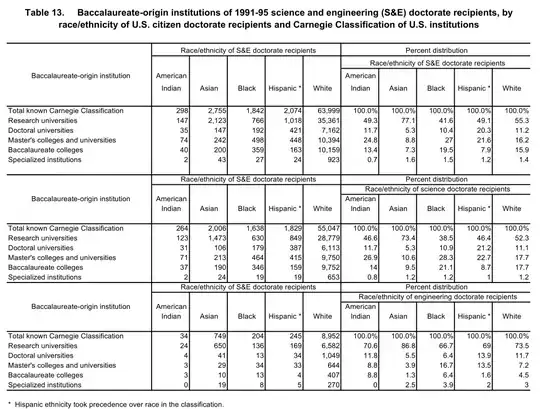According to the 1990-1995 National Science Foundation study on the origins of bachelor degrees in PhD-holding scientists and engineers, black scientists and engineers (PhD holders) have a significantly lower percentage that graduated from research-oriented, elite universities. The disparity is larger for scientists than for engineers.
In the study, the classifications of universities were defined as follows:
Research Universities are the 125 leading universities in terms of
Federal financial support of research and development; they awarded at
least 50 Ph.D.’s each year. Examples include University of California
at Berkeley (CA), University of Texas at Austin (TX), Duke University
(NC), and University of Chicago (IL).
Doctoral Universities are the major doctoral-granting institutions.
The established doctoral programs of these institutions have awarded
at least 20 Ph.D.’s in any field, or 10 Ph.D.’s in three or more
fields. Examples include Iowa State University (IA), University of
South Florida (FL), Howard University (DC), and Rensselaer Polytechnic
Institute (NY).
Master’s Colleges and Universities offered a full range of
baccalaureate programs and are committed to graduate education through
the master’s degree. They award 20 or more master’s degrees annually
in one or more disciplines. Examples include Glassboro State College
(NJ), Old Dominion University (VA), Creighton University (NE), and
Aquinas College (MI).
Baccalaureate Colleges are predominantly bachelor’s-degree granting
institutions that award 40 or more of their degrees in liberal arts
fields. Institutions such as Oberlin College are included, even though
they have master’s degree programs. This category also includes a
group of colleges that awarded less than half their degrees in liberal
arts fields, but were too small (i.e., less than 1,500 students) to be
considered “master’s.” Examples of colleges in this category include
Reed (OR), Bryn Mawr (PA), College of Charleston (SC), and Fisk
University (TN).
Specialized Institutions focused primarily on technical, professional,
or corporate programs in a range of areas such as theology, medicine,
engineering, business, art, music, law, and teaching. Examples of
specialized institutions include New Jersey Institute of Technology,
Princeton Theological Seminary (NJ), University of Oklahoma Health
Science Center, and Teacher’s College of Columbia (NY).
This table from the appendices lists the number and percentage of PhD holders separated by ethnicity and undergraduate instutition. The first table combines scientists and engineers, the second table lists only scientists, and the third table lists only engineers.

It can be seen that both scientist and engineer PhD holders had a lower percentage of blacks who received their undergraduate degrees from research universities, as compared to whites, Hispanics and Asians. For both categories, black PhD holders had the lowest percentages of graduates from research universities.
